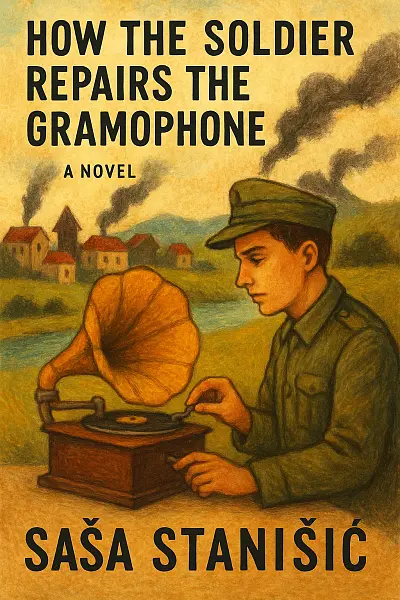
How the Soldier Repairs the Gramophone
by: Saša Stanišić
Aleksandar grows up in the vibrant, magical town of Višegrad, where his imagination colors daily life and stories are his way of understanding the world. Everything changes when his beloved grandfather dies, pushing Aleks to use his storytelling gifts to cope with loss. But as war creeps closer, Aleks and his family are forced to flee to Germany, leaving behind not just their home, but Asija—the mysterious girl he's desperate to protect.
Haunted by questions and yearning for connection, Aleks determines to return, risking heartbreak to seek the truth. Told with a playful, lyrical style, this novel feels bittersweet, dreamlike, and deeply personal.
"Memory is the glue that holds together the broken songs of our lives, even as the future rewinds and plays them anew."
Literary Analysis
Writing Style
Atmosphere
Dreamlike, bittersweet, and occasionally chaotic — The book’s setting shimmers between the magical and the brutal, conjuring up both the whimsical innocence of childhood and the suffocating tension of war. Expect a collage of vivid sensory moments, fragmented memories, and the hazy unreality that often colors recollections of trauma or exile. You’ll feel the lively bustle of Bosnian village life, only to be unsettled by the slow-creeping dread of conflict.
Prose Style
Playful, energetic, and daringly experimental — Stanišić’s sentences zigzag with poetic flair, jumping from rapid-fire lists to dreamy tangents and back again. The voice is youthful, self-aware, and riddled with wry humor, sometimes slipping into surrealism or breaking the fourth wall to address the reader directly. Be ready for sudden shifts in tone and perspective, a patchwork that captures the messy, nonlinear nature of memory.
Pacing
Unpredictable and deliberately uneven — The narrative isn’t so much a straight road as a series of winding detours. Moments of breathless, staccato action are followed by long, meditative pauses. Some chapters speed past in a blur, while others linger on small, quiet details. This can be exhilarating but may feel disorienting if you’re craving a tidy, orderly plot.
Characterization
Vivid, quirky, and deeply human — Characters are drawn with loving detail and offbeat charm, their eccentricities shining through even amidst tragedy. Relationships and personalities often telescope through the eyes of a child narrator, giving scenes a sense of wonder or surreal distortion. Secondary characters—grandparents, neighbors, friends—are rendered with warmth and specificity, though the fragmented style can make it harder to grasp their inner worlds fully.
Themes and Tone
A tug-of-war between nostalgia and loss — There’s a persistent tension between the joys of life—music, laughter, family stories—and the sharp ache of things lost. Themes of displacement, memory, and the slipperiness of truth recur throughout, accented by a blend of biting irony and hopeful longing. The book balances heartbreak with flashes of wit and absurdity, so you’re left feeling both unsettled and strangely uplifted.
Overall Feel
Inventive, kaleidoscopic, and emotionally resonant — If you like your literary fiction sprinkled with dark humor, unconventional structure, and plenty of heart, this novel’s bold style and poignant nostalgia will definitely sweep you off your feet—just don’t expect a straightforward, easy ride.
Key Takeaways
- Childhood memories splintered by the siege, told through bursts of poetic, surreal narration
- Aleksandar’s games of “what if” becoming both survival tactic and narrative magic trick
- Grandpa Slavko’s funeral—equal parts heartbreaking and absurd—captures the book’s bittersweet humor
- "Letter to Asija": hope, longing, and the ache of lost friendship distilled into a single, unforgettable chapter
- War seen through a child's eyes—innocence clashing with brutality in every page
- Time jumps and fragmented storytelling mirror identity fractured by displacement
- Lists, jokes, and tall tales—language itself becomes a weapon against loss

War-torn childhoods, reimagined through whimsical, magical storytelling
Reader Insights
Who Should Read This
If you’re the kind of reader who loves books that blend a bit of magical realism with coming-of-age stories, and you don’t mind a few emotional punches along the way, How the Soldier Repairs the Gramophone is one you’ll want to add to your list.
- Fans of literary fiction, especially those who appreciate playful, inventive storytelling (think along the lines of Salman Rushdie or Jonathan Safran Foer), will get a real kick out of Stanišić’s quirky, poetic style.
- If you’re fascinated by stories that explore memory, war, displacement, and the resilience of childhood imagination, there’s a good chance you’ll fall completely in love with this book. It’s especially great for folks interested in the Balkan conflict, or anyone who likes reading about how big, scary things are viewed through a child’s eyes.
- Love a book that makes you laugh one minute and tugs at your heart the next? This balances that bittersweet vibe really well.
- If you’re a sucker for a novel with unexpected narrative turns and unconventional structure, you’ll enjoy the way the story skips around and refuses to stay put.
On the flip side...
- If you only enjoy super-straightforward plots or get frustrated when stories wander or experiment with time and voice, this might drive you a little nuts. It’s definitely not a classic, linear read.
- Also, if lyrical language or a dreamlike narrative aren’t your thing, and you prefer simple, down-to-earth prose, you’ll probably want to skip this.
- While it certainly packs a punch, be prepared—there are heavy themes, so anyone looking for a light, breezy escape might find it a bit intense.
So, if you’re game for something that’s both heartfelt and slightly offbeat, with a swirl of history, family, and imagination, this could be your next favorite. But if you need things tied up neatly and hate ambiguity, maybe reach for something else.
Story Overview
If you’re ready for a blend of nostalgia, heartbreak, and quirky humor, How the Soldier Repairs the Gramophone is one wild, unforgettable ride you won’t want to miss.
Set in the turbulent backdrop of war-torn Bosnia, this novel introduces you to Aleksandar, a young boy whose vivid imagination and deep love for his family color his every experience. As conflict encroaches on his once-idyllic hometown, Aleksandar’s journey becomes a search for meaning, connection, and hope in a world turned upside down.
With its vibrant mix of magical realism, bittersweet memories, and sharp wit, the book captures both the pain and resilience that define coming-of-age in extraordinary times.
Main Characters
-
Aleksandar Krsmanović: Wonderfully imaginative young narrator whose memories shape the nonlinear storytelling. His longing to preserve his homeland’s stories reflects his struggle with identity and loss.
-
Grandfather Slavko: Aleksandar’s beloved grandfather, a storyteller and central figure in his childhood. His sudden death acts as a catalyst, symbolizing the rupture caused by war.
-
Asija: Aleksandar’s close childhood friend and confidante, marked by their innocent bond and shared escapism. Her fate haunts Aleksandar, representing all that is lost in war.
-
Micika (Aleksandar’s Mother): A practical, nurturing force anchoring the family through trauma and displacement. Her resilience grounds Aleksandar amid fragmentation.
-
*Zeljko (Aleksandar’s Father): A quieter presence, emblematic of parental love and the silent toll of upheaval. His emotional distance mirrors the challenges of migration and starting anew.
If You Loved This Book
If How the Soldier Repairs the Gramophone won you over with its dreamlike, fragmented narrative and bittersweet look at childhood, you might find yourself instantly reminded of Jonathan Safran Foer's Everything Is Illuminated. Both novels balance tragedy and whimsy, weaving magical realism and inventive structure into tales ricocheting between humor and heartbreak against the backdrop of war. The way Stanišić conjures memories and family echoes the playful yet gut-punching storytelling style that Foer fans swear by.
On another note, if the collision of innocence and war tugged at your heart, Markus Zusak's The Book Thief comes to mind—both stories filter atrocity through a child’s eyes, offering lyrical, sometimes surreal prose that finds glimmers of wonder in bleak times. Stanišić and Zusak alike paint their worlds with bold emotional colors, fusing hopefulness and sorrow in unforgettable imagery.
Visually, readers might find themselves flashing to the film Amélie, with its kaleidoscopic memory sequences and vibrant emotional palette. Like the movie, Stanišić’s novel revels in quirky characters and a sense of magical possibility even amidst heaviness, inviting us to see the world as a jumble of wonder, loss, and love—making the surreal heartbreak and joy leap right off the page.
Expert Review
What survives when memory unravels in the face of loss and war? Saša Stanišić’s How the Soldier Repairs the Gramophone is a luminous meditation on the possibility—and futility—of storytelling as a way to hold a world together once it splinters. Seamlessly fusing magical realism and lived history, Stanišić challenges us to consider how myth, grief, and the compulsion to remember shape and distort the narratives we construct about home, childhood, and survival.
Stanišić’s prose, effortlessly translated by Anthea Bell, dazzles with its inventive energy and linguistic playfulness. The novel melds fragmented scenes, switching between first- and third-person perspectives, past and present, conjuring the disorienting effects of trauma—but also the wildly creative ways the young narrator Aleksandar interprets the world. Stanišić excels at rendering the mundane magical; a favorite uncle’s tall tales burst into surrealism, and even the horrors of conflict are filtered through offbeat, kaleidoscopic imagery. But beneath the exuberance, the prose sometimes skitters toward excess. While Aleksandar’s voice is charming and original, the frenetic pace and narrative jumps may test readers’ patience, occasionally sacrificing clarity for style. Still, the language’s emotional immediacy—sometimes poetic, sometimes blunt—imbues scenes with striking honesty, and Bell’s translation preserves its inventiveness.
At its heart, the novel reckons with the frailty and necessity of memory. Stanišić wraps trauma in layers of humor, folklore, and childhood fantasy, allowing grief and loss to coexist with genuine moments of joy. The story navigates the legacy of war—how violence echoes through generations and places, and the ways displacement reshapes identity. Aleksandar’s attempts to “repair” the past by collecting stories feel especially relevant in an era when personal and national histories are contested and volatile. The novel also asks: What does it mean to belong when your country, your language, your childhood itself are lost or fractured? In the interplay between forgetting and remembering, Stanišić suggests there are no neat answers—only ongoing acts of invention and retrieval. His blend of nostalgia and heartbreak cuts through the abstraction, making the pain of exile and longing for home immediate and vital.
Within the tradition of post-Yugoslav and war literature, Stanišić’s voice is distinctive—more whimsical than Hemon or Albahari, less didactic than Andrić. By seeing conflict through a child’s bewildered eyes, he sidesteps cynicism and instead achieves a fragile, almost defiant hope. This novel nestles comfortably among magical realist works by Marquez and Rushdie, but with a pointed Balkan melancholy all its own.
Occasionally uneven pacing and narrative fragmentation can muddy the emotional arc, but Stanišić’s innovation and empathy shine through. For readers willing to embrace its stylistic risks, How the Soldier Repairs the Gramophone is a testament to the power—and the limitations—of storytelling, and a stunning addition to contemporary literature on exile and remembrance.
Community Reviews
I CAN'T STOP THINKING ABOUT THE SCENE WITH THE CHILD AND THE BROKEN GRAMOPHONE. It twisted my insides, made me question what innocence survives in war. That image lingers, stubborn as a ghost.
I STILL CAN'T GET NADENKA OUT OF MY HEAD. HER PRESENCE LINGERS LIKE STATIC AFTER A STORM. THE WAY SHE SHAPES THE STORY—IT'S UNSETTLING, INESCAPABLE, SHE'S EVERYWHERE AND NOWHERE.
That scene where Aleksandar tries to make sense of the grownups’ secrets? It stuck with me, like a memory you can’t shake. Stanišić nails the confusion of childhood in war. I kept thinking about it long after closing the book.
Honestly, I can't get Armin's voice out of my head. His memories are wild rivers, and I kept flipping pages hoping he’d finally rest. But no, he lingers, he haunts, he makes you question what’s left behind.
i can't stop thinking about Aleksandar’s wild storytelling, how he spins grief and humor together until you don't know if you should laugh or cry. that one scene with the river just LIVES in my head.
Cultural Context & Discussion
Local Perspective
How the Soldier Repairs the Gramophone strikes a deep chord with readers in German-speaking countries due to its evocative portrayal of war, memory, and identity—themes that are profoundly relevant in the local context.
-
Parallel historical events: The novel’s backdrop of the Bosnian War immediately echoes Germany’s own grappling with World War II, the Balkan conflicts of the 1990s, and the complexities of migration and displacement. Many here have lived through—or inherited—memories of forced migration and divided identities.
-
Cultural values: The book’s celebration of narrative resilience resonates with the German value placed on Erinnerungskultur (culture of remembrance) and the power of storytelling to process trauma. Yet, its playful, magical-realist style contrasts sharply with the often sober tone of local war literature—making its emotional outbursts and surreal humor feel both fresh and, at times, jarringly unconventional.
-
Plot points: Scenes of family disintegration and refugee life land harder here, as many readers connect them directly to Germany’s own refugee experiences, both historic and recent.
-
Literary traditions: Stanišić’s fragmented, poetic structure challenges classic German literary conventions—think Thomas Mann’s orderliness—while echoing the fractured narratives of W.G. Sebald. It’s a welcome shake-up that brings fresh perspectives to long-standing conversations around identity and belonging in Germany.
Honestly, this book’s bittersweet tone and inventive storytelling both fit in and stand out, making it a thought-provoking gem for readers attuned to questions of memory and migration.
Points of Discussion
Notable Achievement
How the Soldier Repairs the Gramophone by Saša Stanišić was shortlisted for the prestigious 2007 Deutscher Buchpreis (German Book Prize) and has since been translated into multiple languages, earning international acclaim for its lyrical style and poignant exploration of memory, war, and childhood.
This novel has become a beloved fixture in discussions about post-Yugoslav literature, celebrated especially for its inventive narrative voice and its heartfelt, whimsical look at the Balkan conflict through the eyes of a child.







